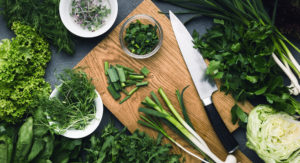
Eat like a Rastafarian
Sodium chloride also known as table salt is an essential component of a healthy diet. It plays a major role in balancing water in the body. But in the developed world we consume far more salt than we actually need. According to the Center for Disease Control (CDC) the American diet contains more than 3500 mg of salt per day. Conversely, many native human populations consume less than one gram per day like the Rastafarians also known as Rastas.
Rastas are a group of people know mostly in Jamaica and Ethiopia and they consume an I-tal diet. The diet is mostly plant based and meatless. The Rastas do not add salt to their food. Since their diet is mostly vegetable, they believe that all the salt the body needs can be found in the vegetables they eat. And they are correct. Although low, some plants naturally contain sodium. Most vegetable fall in the sodium free or low sodium category. To add flavor to their food, they use herbs. Therefore, it is possible to enjoy a meal without added salt.
Lower Your Blood Pressure Naturally
If you have high blood pressure or want to prevent high blood pressure the American Heart Association recommends consuming less than 1500mg/day. This low sodium diet option will decrease your blood pressure by about 5 – 6mm Hg.
Although this might not seem like a significant reduction, even a small decrease can prevent you from progressing to a higher stage in the blood pressure range. On the contrary you can also move to a lower stage with a decrease in blood pressure.
Given that eating too much salt is so bad for us, how can we reduce the amount we eat? Follow the six tips below and see how you get on.
1.Beware of Processed Food
Contrary to what you might believe the added sodium is not from table salt but is from processed and restaurant food. Due to our busy lives we eat out too much and turn to fast food for a quick meal. As much as three-quarters of the salt we consume comes from processed foods. Everyday items such as bread, soup, breakfast cereals, stock and processed meats, including sausages and ham, contain high levels of salt. It isn’t always possible to cook everything from scratch, but try cereals with no salt, like porridge or muesli, and stick to homemade soups and stocks. These can be made in large volumes and frozen for later use. If you have a large family, invest in a bread maker. You will reduce your salt intake and save money. Lastly, look out for salt in canned vegetables and choose those with no added salt. Here are some examples comparing natural and processed foods:
- Salmon Raw 110 mg serving, canned 570mg, smoked 1880mg
- Peas Raw Trace Canned 250mg
2.Don’t Add Extra Salt
Avoid adding salt to food during preparation or at the table. Remember, the more salt you consume, the more your taste buds rely on it to taste food. You can wean your taste buds off salt. As you reduce your salt intake your sense of taste will improve over a few weeks. If you do need to add salt, add it after you cooked and taste the food. Ask yourself if you really need that added salt.
3.Use Good Raw Ingredients When Cooking
Some food ingredients in pre-prepared meals are unrecognizable. If it has too many syllables or you cannot pronounce it or spell it you probably should not eat it. Preservative and salt is added to packed food to keep it on the shelves or in a bin for years. In addition, since salt is cheap, it is included in processed foods to allow the amount of expensive ingredients to be reduced. A 260z container of salt cost about $5-$7 US.
4.Spice It Up
Use alternative flavor enhancers like garlic, pepper, herbs, chili, wine and lemon juice. These will add flavor and make food more interesting without increasing the salt content. No MSG. Choose low sodium soy sauce. Sea and Kosher salt also contain sodium so use them sparingly.
5.Eating Out
The cooks in restaurants don’t care about your health. Nor do they track the amount of salt they add to the dish. Don’t bother asking about salt content when eating in restaurants. You will not get a correct amount. It’s best to assume it’s high. Additionally, be aware that condiments such as tomato ketchup, salad dressing, mayonnaise and soy sauce can contain high sodium levels.
6.Track Your Salt Intake
Be salt-aware and try to stick to the daily target of 2300mg or fewer per day. Food labels now display salt content, so check these carefully. Be aware that the sodium content may be given rather than the salt content. Multiply the sodium value by two-and-a-half to calculate the salt content, e.g., one gram of sodium is equivalent to two-and-a-half grams of salt.
Sometimes it hard to figure out the serving size of food. The package is not always clear and it gets confusing when you start adding ingredients . For instance, when you are making pancake and you add the dry mix plus butter , egg and whatever else it calls for, can you really calculate the sodium content correctly? Remember, unless stated the nutrition information is not per package but per serving. Look for food with the below amount of sodium as follows:
- No added Sodium
- Vey low sodium- 35mg or less
- low sodium-140mg or less
Dieticians are experts on food and nutrition. They spend years in school studying how food affects our body. Talk to a dietician if you can. They can further guide you on how to manage your sodium intake.
